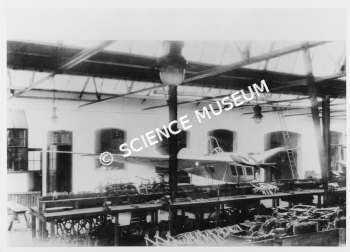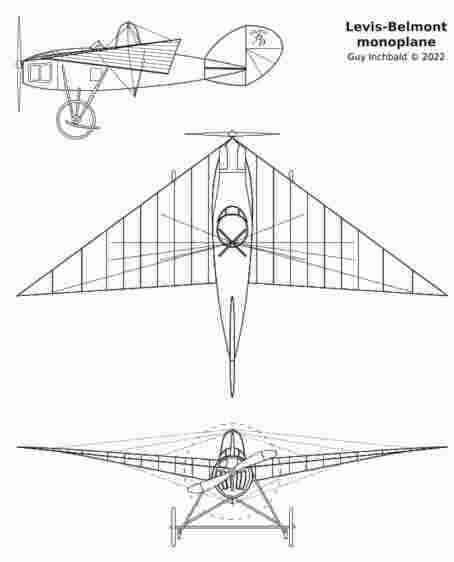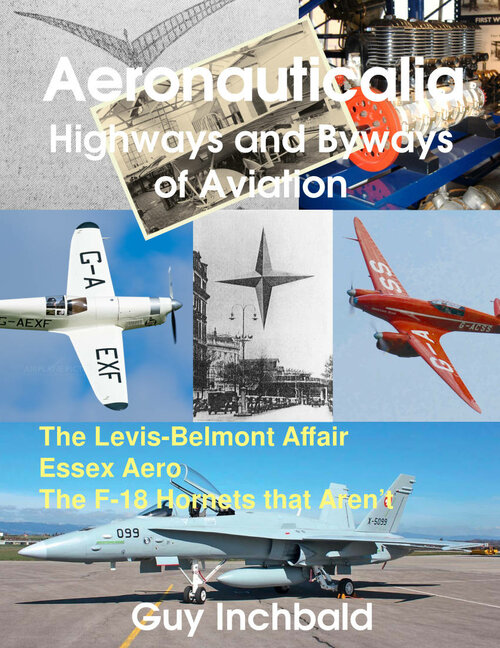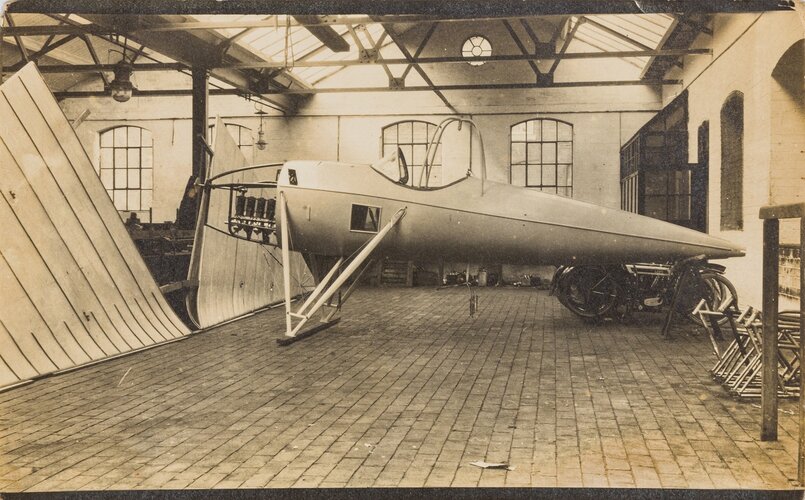- Joined
- 25 June 2014
- Messages
- 1,564
- Reaction score
- 1,483
The James monoplane is an elusive but potentially hugely significant pioneer aircraft. One day shortly before the First World War a Mr. James walked into the Butterfield Brothers' Levis motorcycle works in Stechford, Birmingham and asked if they could build a 35 hp lightweight aero engine to his specification. Not only did their Mr. Newey design and make the desired five-cylinder inline two-stroke engine, but they set three deaf-mute carpenters to building the whole aircraft. The name "Leonie" was painted on the rudder. On completion, the plane was taken to Castle Bromwich Playing Fields, where it ignominiously ended its career by hitting a goal post during an attempted take off. It was taken back to the works and, following the outbreak of war, dismantled. In 1953 the engine was found, restored and given to the London Science Museum, where it remains on display to this day - there is a photo at https://www.flickr.com/photos/cliffpatte/13952553941/ It was the only aero engine Levis ever made.
The main source for all this is a cutting, describing the rescue, from The Birmingham Post, Wednesday 2 Sept 1953.
What of the importance? James was assisted by one Lieutenant Dunne, said to have patented the aircraft wing and to be the same Lt. J.W. Dunne who once worked at Farnborough in its days as the Army Balloon Factory. The wing is unusual, being "triangulated" and gently swept to form something resembling a modern delta wing. Dunne was famous for his tailless swept "arrow-head" designs, but they all had constant-chord wings (and no rudders). Except, his patents tell a wider story. His original patent 08,118 of 1909 includes, as Fig.3, what we know of today as the classic Rogallo sailwing - a delta planform with conical upper surface. However the photo of the James monoplane reveals a wing which, although sagging and unbraced, appears not to have the standard Dunne conical development. In his patent 26,441 of the same year he includes a drawing of something not far off the James design, having moderately swept wings with pointed tips. This patent is also unusual for Dunne in that it describes the use of additional stabilising planes, typically canard but a tail is explicitly allowed in the text, where the sweep is too shallow for Dunne's usual design to work. Could this be the patent referred to? Could the James monoplane have had a tail? The only photo I have ever seen has that rear fuselage hidden and one cannot say. We know that GTR Hill, jack Northrop and Alexander Lippisch all paid homage to Dunne and that the Me163 Komet, Short's aeroisoclinic wing testbed and Northrop B-2 bomber are in direct lineage of his earlier machines. Glenn Curtiss worked on the Dunne design, collaborating on the Smith B-2 "Arrowhead" in the 'thirties. Dunne's patent extends his ideas to both tapered, pointed wings and to designs with stabilisers. The James monoplane now offers the possibility that it was the direct ancestor of the Lippisch Deltas, Curtiss XP-55, Me262 and just about every fast jet ever given a reduced incidence to the outer wing. So I'd kind of like to find out whether it had a tail or not.
Another uncertainty arises over the date. The Birmingham Post gives it as 1913, as recollected by surviving workers from the factory. But the engine cylinder size, 349 cc, does not seem to have appeared on a production bike until 1915 (though I cannot confirm this).
Then, I stumbled on an item in Flight, 19 March 1915, p196:
"A correspondent in the Midlands tells me that Mr. S. Summerfield is at present testing a new monoplane which is designed to be automatically stable. Details of the new machine are lacking, but in general appearance it is said to be somewhat similar to the Dunne, although the means of control are entirely different. The engine fitted is also of new design, a five-cylinder two-stroke,
which, I understand, has given surprisingly good results."
This description matches the James monoplane very well, save only the two-year date discrepancy. Is it more likely that two craft with unusual and independently-designed five-cylinder two-stroke engines and a strong affinity to the (otherwise passé) Dunne but differing controls, should attempt to fly in the Midlands but fade from sight within two years of each other, or that Mr. James did what a lot of Midland designers were doing at that time and engaged the services of a well-known local test pilot, Sam Summerfield, and that those old Levis workers were a couple of years out in their recollections?
Other sources for the James monoplane include Lewis British Aircraft 1809-1914, from whom I took the name. For some reason Lewis says the engine was installed inverted. Inspection of the surviving photo shows this to be incorrect: the crankshaft output is at the bottom and a separate propeller shaft at the top. Calculation based on the required propeller speed and the engine revs stated by the museum show that this must have involved a drive chain or belt with a 2:1 reduction ratio (Levis bikes of the day were famously belt-drive but the restored engine has a pinion gear). The less said about Goodall and Tagg's British Aircraft before the Great War the better. They mix it up with the Dunne D.9, writing in the text that it is a pusher while showing the photo which is clearly of a tractor, while on seeing the rudder leaned up against the undercarriage struts they mistake it for a wheel spat. Consequently some other tidbits they offer, such as Fairey's involvement (presumably in his role as General Manager of Dunne's old company, but for which aircraft?), cannot be assessed.
Another mystery is the pedigree of Mr. James. There was a James cycle co. of several generations standing, just down the road from the Levis works. Was our Mr. James a family member, acting with or without the approval of any still involved in their own company? In the annals of Flight, a couple of James brothers appear learing to fly in Wales, and other escapades. But James is a common enough surname.
There is a copy of the photo on flyingmachines.ru, a copyvio site, so I am not sure if I can link to it from here. Can I post the newspaper clipping from 1953? I can surely post extracts from the relevant Dunne patents, or link to them on the EU online database, if that helps?
Meanwhile, does any of this jog someone's memory? I'd love to have at least some of these puzzles resolved.
The main source for all this is a cutting, describing the rescue, from The Birmingham Post, Wednesday 2 Sept 1953.
What of the importance? James was assisted by one Lieutenant Dunne, said to have patented the aircraft wing and to be the same Lt. J.W. Dunne who once worked at Farnborough in its days as the Army Balloon Factory. The wing is unusual, being "triangulated" and gently swept to form something resembling a modern delta wing. Dunne was famous for his tailless swept "arrow-head" designs, but they all had constant-chord wings (and no rudders). Except, his patents tell a wider story. His original patent 08,118 of 1909 includes, as Fig.3, what we know of today as the classic Rogallo sailwing - a delta planform with conical upper surface. However the photo of the James monoplane reveals a wing which, although sagging and unbraced, appears not to have the standard Dunne conical development. In his patent 26,441 of the same year he includes a drawing of something not far off the James design, having moderately swept wings with pointed tips. This patent is also unusual for Dunne in that it describes the use of additional stabilising planes, typically canard but a tail is explicitly allowed in the text, where the sweep is too shallow for Dunne's usual design to work. Could this be the patent referred to? Could the James monoplane have had a tail? The only photo I have ever seen has that rear fuselage hidden and one cannot say. We know that GTR Hill, jack Northrop and Alexander Lippisch all paid homage to Dunne and that the Me163 Komet, Short's aeroisoclinic wing testbed and Northrop B-2 bomber are in direct lineage of his earlier machines. Glenn Curtiss worked on the Dunne design, collaborating on the Smith B-2 "Arrowhead" in the 'thirties. Dunne's patent extends his ideas to both tapered, pointed wings and to designs with stabilisers. The James monoplane now offers the possibility that it was the direct ancestor of the Lippisch Deltas, Curtiss XP-55, Me262 and just about every fast jet ever given a reduced incidence to the outer wing. So I'd kind of like to find out whether it had a tail or not.
Another uncertainty arises over the date. The Birmingham Post gives it as 1913, as recollected by surviving workers from the factory. But the engine cylinder size, 349 cc, does not seem to have appeared on a production bike until 1915 (though I cannot confirm this).
Then, I stumbled on an item in Flight, 19 March 1915, p196:
"A correspondent in the Midlands tells me that Mr. S. Summerfield is at present testing a new monoplane which is designed to be automatically stable. Details of the new machine are lacking, but in general appearance it is said to be somewhat similar to the Dunne, although the means of control are entirely different. The engine fitted is also of new design, a five-cylinder two-stroke,
which, I understand, has given surprisingly good results."
This description matches the James monoplane very well, save only the two-year date discrepancy. Is it more likely that two craft with unusual and independently-designed five-cylinder two-stroke engines and a strong affinity to the (otherwise passé) Dunne but differing controls, should attempt to fly in the Midlands but fade from sight within two years of each other, or that Mr. James did what a lot of Midland designers were doing at that time and engaged the services of a well-known local test pilot, Sam Summerfield, and that those old Levis workers were a couple of years out in their recollections?
Other sources for the James monoplane include Lewis British Aircraft 1809-1914, from whom I took the name. For some reason Lewis says the engine was installed inverted. Inspection of the surviving photo shows this to be incorrect: the crankshaft output is at the bottom and a separate propeller shaft at the top. Calculation based on the required propeller speed and the engine revs stated by the museum show that this must have involved a drive chain or belt with a 2:1 reduction ratio (Levis bikes of the day were famously belt-drive but the restored engine has a pinion gear). The less said about Goodall and Tagg's British Aircraft before the Great War the better. They mix it up with the Dunne D.9, writing in the text that it is a pusher while showing the photo which is clearly of a tractor, while on seeing the rudder leaned up against the undercarriage struts they mistake it for a wheel spat. Consequently some other tidbits they offer, such as Fairey's involvement (presumably in his role as General Manager of Dunne's old company, but for which aircraft?), cannot be assessed.
Another mystery is the pedigree of Mr. James. There was a James cycle co. of several generations standing, just down the road from the Levis works. Was our Mr. James a family member, acting with or without the approval of any still involved in their own company? In the annals of Flight, a couple of James brothers appear learing to fly in Wales, and other escapades. But James is a common enough surname.
There is a copy of the photo on flyingmachines.ru, a copyvio site, so I am not sure if I can link to it from here. Can I post the newspaper clipping from 1953? I can surely post extracts from the relevant Dunne patents, or link to them on the EU online database, if that helps?
Meanwhile, does any of this jog someone's memory? I'd love to have at least some of these puzzles resolved.






